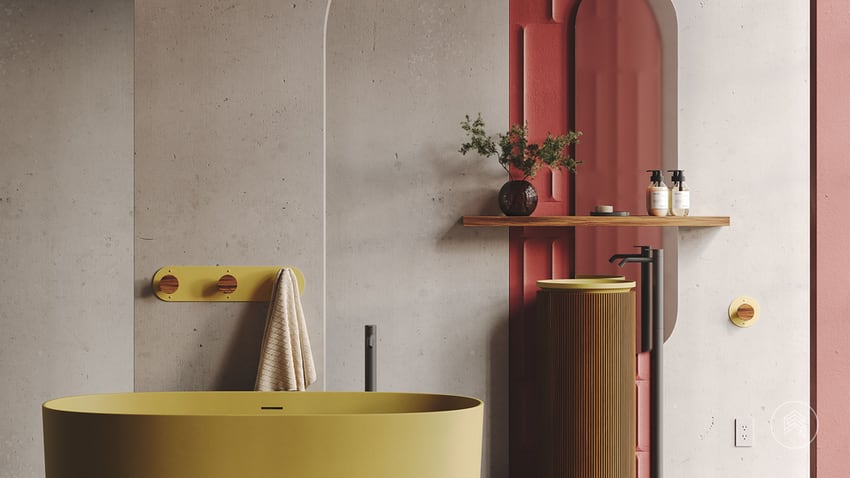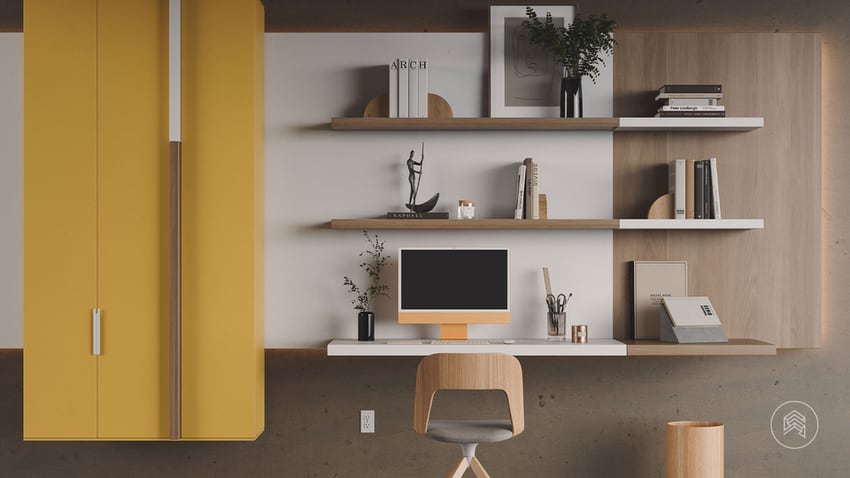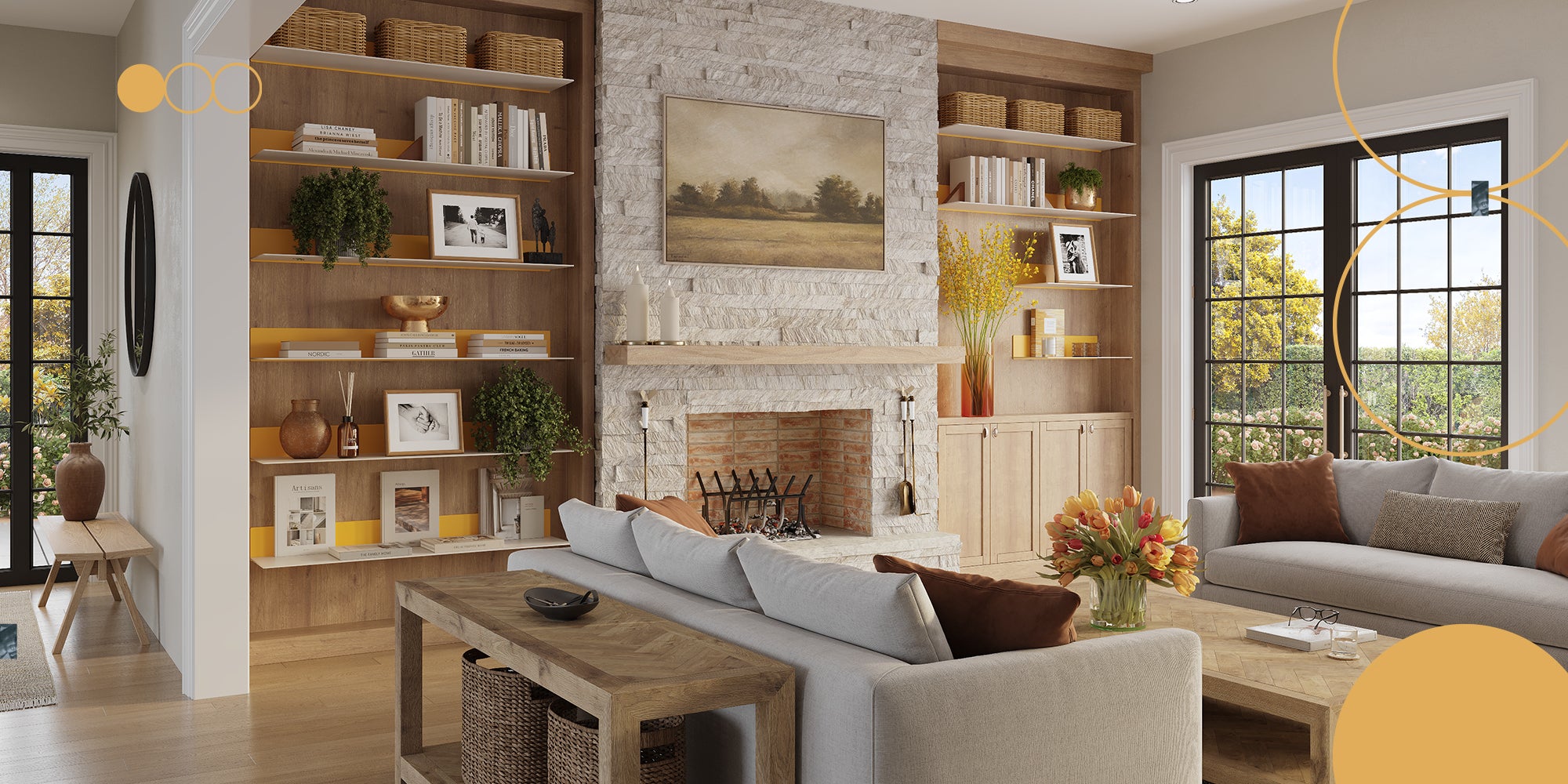When you think of mid-century modern design, perhaps the set of Mad Men comes to mind. You may recall the 1960s period drama (that won 16 Emmys) starring the infamous Don Draper (John Hamm) and copywriter Peggy Olson played by Elizabeth Moss pre-Handmaid's Tale.
While the mid-century modern aesthetic captured the zeitgeist of the ‘60s, open any modern or vintage design magazine or blog today, and you’ll see images of the stylish decor splashed on nearly every page.
Many of us can’t get enough of this timeless trend that showcases simplicity, open space, and natural materials––and is enhanced by (you guessed it) floating shelves.

To help you do mid-century modern like a pro, we reached out to design experts for some insight and inspiration.
MEET THE DESIGNERS
Debby Katz, Interior Designer and founder of Debby Katz Interiors in Connecticut.
Chris Daddio, Cabinet Designer and owner of Wood & Co. based in New York.
A Brief History of Mid-Century Modern (MCM) Design
Influenced by the Bauhaus Era, mid-century modern design evolved from the modernist movement (mid-1940s to the mid-1960s). Arising shortly after World War II, MCM rose to prominence in the 1950s and permeated the interior design scene by the ‘60s. One of the first furniture pieces was George Nelson’s mass-produced platform bench. Nelson wanted to make furniture affordable and accessible to middle-class homeowners, not just the rich.
Mid-century modern designers pushed the boundaries by experimenting with new shapes and forms dramatically different from the highly decorative and ornate designs found in Victorian and Art Nouveau interiors earlier in the 20th century.
Characteristics of Mid-Century Modern

Characterized by its simple, open spaces, clean, sleek curved and straight lines and asymmetrical shapes, mid-century modern spaces were designed to be aesthetically striking and beautiful, yet functional for living. Rooms displayed an abundance of empty space and welcomed nature indoors. Let’s take a closer look at MCM’s unique qualities.
Color Palettes
Color palettes in mid-century modern design allows homeowners the freedom to play with color. In a mid-century modern space, you can mix colors together, use neutral hues with pops of color, or create a monochromatic color palette with varying shades of the same color. However, earth tones take center stage. “MCM style really embraces the idea of welcoming the outdoors “in'' so a color palette dominated by muted colors that reference nature––deep greens, burnt orange, [mustard yellow,] and more subtle shades of yellow that are deep and warm are important,” explains Katz.
Open Shelving
Space is the most important element in design, and mid-century modern seeks to maximize the volume of each space, says Daddio. “Floating shelves allow the eyes to travel, uninterrupted, unbounded, which creates an increased feeling of space and openness.”
“Enclosed bookcases and large shelving units, [on the other hand], often create an overbearing presence in a room, reducing the room's open space, and competing against a mid-century modern aesthetic.”
A Mix of Organic and Man-made Materials
We see natural and fabricated materials in the mid-century modern home that include wood, marble, metal, leather, vinyl, and fiberglass. Pieces often mixed materials in one item such as a walnut tabletop with a metal base or a leather chair with chrome legs and arms.
Mid-century modern furniture and interiors are typically composed of dark woods, such as walnut,” explains Daddio. “Alternative woods with similar color tones can be used for a slightly different look such as olive wood.” Another popular wood used with mid-century modern is teak.
“If you are looking to achieve a different color palette, you can maintain the typical thin, clean line styling of MCM and execute it in white oak; white oak is a very workable wood that takes various stains and colors well.”
Iconic Mid-Century Modern Furniture
From straight and angled peg legs to pedestal bases, from curved to straight arms, from hardwood to plywood and metal, MCM furniture design pushed the limits of variety. You can still find many original pieces, reproductions, and replicas today in antique stores, brick-and-mortar stores, and online retailers such as Design Within Reach, Knoll, Herman Miller, 1stDibs, and West Elm.
The following is a short list of iconic mid-century modern furniture pieces and their designers:
-
Eames Lounge and Ottoman (Charles and Ray Eames)
-
Eames Molded Fiberglass Side Chair (Charles and Ray Eames)
-
Barcelona Chair and Sofa (Mies van der Rohe)
-
Egg Chair (Arne Jacobsen)
-
Swan Chair (Arne Jacobsen)
-
Number Seven Chair (Arne Jacobsen)
-
Wassily Chair (Marcel Breuer)
-
Noguchi Coffee Table (Isamu Noguchi)
-
Marshmallow Sofa (George Nelson)
-
Pretzel Armchair (George Nelson)
-
Pedestal Dining Table and Pedestal Chair (Eero Saarinen)
-
Tulip Armchair and Tulip Chair (Eero Saarinen)
-
Womb Chair (Eero Saarinen)
-
Florence Knoll Sofa (Florence Knoll)
Art
Popular mid-century art included abstract expressionism, a type of art used in advertising as well as pop art (comic book art) pioneered by Roy Lichtenstein. Mid-century modern artwork compositions featured geometric shapes and bright colors. Table sculptures could be cast in wood, bronze, brass, steel, and other metals.
Nature
Nature is always a prominent element in the mid-century modern home. Architects such as Frank Lloyd Wright-designed houses with larger-than-life windows so rooms could flood with natural light and reflect the natural environment. The aim: design the home to invite in as much sunlight and flora as possible. By hanging plants from floating shelves and ceilings, one can experience the natural realm indoors.
But there are many ways to bring the outdoors “in”, in addition to using plants, according to Katz. “Consider natural fibers––things like wood, wool, alpaca, and cork to add an organic and nature-inspired touch to an indoor space. These elements will also add warmth and texture.”
Images of nature in graphic form on fabric and wallpaper can also evoke images of the outdoors, says Katz. “Artwork is a fantastic way as well––everything from paintings and photos of nature to more abstract or graphic representations of nature that conjure up the great outdoors.”
Tips for Designing a Mid-Century Modern Home, Room by Room
Read on for some authentic ideas to decorate your home in mid-century modern style.
In The Living Room

In the living room, start with iconic seating inspired by the tufted Florence Knoll Sofa or loveseat in fabric or leather in brown, caramel, green, ivory, or gray. You can find this style in many furniture stores. Add a Barcelona chair and a vintage or modern kidney-shaped coffee table, and a Noguchi-inspired lamp. Create a feature wall in an asymmetrical design above the sofa or around the fireplace with floating shelves by gradually varying the length of your shelving from short to long.
In The Kitchen

Begin your kitchen design with a round or rectangular-shaped mid-century modern dining table in a walnut or acorn finish. Choose an expandable table that can open for larger gatherings.
For the wall, choose floating shelves to coordinate with your cabinets. “The movement eschews clutter, so aim for a few carefully curated objects and books when styling your floating shelves,” says Katz. “Geometric shapes mixed in with organic, funky-shapes (Sputnik-like) are great opportunities to add some flair and personality.”
In The Bedroom

For your mid-century modern sanctuary, choose wood furniture in walnut or teak. Select a dresser or chest of drawers with tapered legs. For a soothing color palette, choose muted hues that inspire peace and relaxation. In a corner, place a tree in an MCM-inspired planter with angled legs (West Elm carries one). Add photos of nature on a floating nightstand to bring in the outdoors.
In The Bathroom

It’s time to toss out that over-the-toilet cabinet. Floating shelves make a much nicer presentation. Style your shelves with a succulent on a shelf and a basket or two to keep your toiletries close. If you have a soaking tub, a floating shelf above it is a great way to store and display extra towels and loofah sponges. For your sink area, consider a mid-century-modern-inspired vanity.
In The Home Office

Open up your floor space in your WFH space with a floating desk from Shelfology. You can have it custom cut to the size of your room and work preferences. For a traditional MCM desk, opt for walnut. You can coordinate the look with a floating bookshelf, or choose a mustard yellow, or burnt orange to make your office pop.
If you’re looking to create a Zoom background, consider creating a feature wall with floating shelves that you can style with books, art, and a sculptural object or two. An Eames desk chair and an Eames lounge to stretch your legs if you have the space will make your MCM home office complete.
Whether you decide to punctuate your home with a few mid-century modern pieces or opt to showcase your entire home in this stylish aesthetic, you’ve got the foundation on how to do mid-century modern like a pro.




Share:
How To Create a Stylish and Cozy Home Library
Certified Rad: Mercury Mosaics + C2S (Part 2)